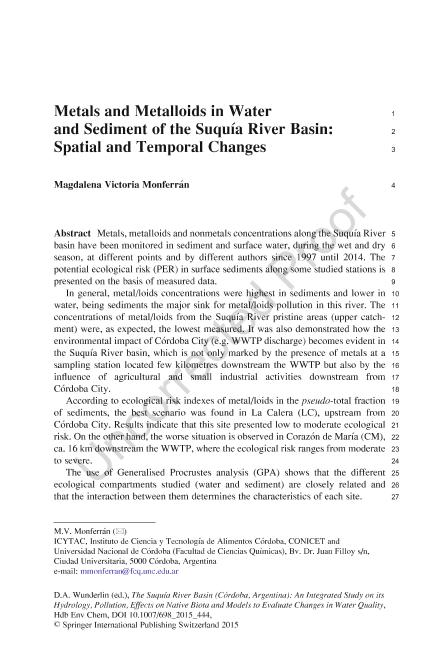Mostrar el registro sencillo del ítem
dc.contributor.author
Monferran, Magdalena Victoria

dc.date.available
2018-06-18T15:23:20Z
dc.date.issued
2015-10
dc.identifier.citation
Monferran, Magdalena Victoria; Metals and metalloids in water and sediment of the Suquía River basin: Spatial and temporal changes; Springer Verlag; Handbook of Environmental Chemistry; 62; 10-2015; 113-143
dc.identifier.issn
1867-979X
dc.identifier.uri
http://hdl.handle.net/11336/48970
dc.description.abstract
Metals, metalloids and nonmetals concentrations along the Suquía River basin have been monitored in sediment and surface water, during the wet and dry season, at different points and by different authors since 1997 until 2014. The potential ecological risk (PER) in surface sediments along some studied stations is presented on the basis of measured data. In general, metal/loids concentrations were highest in sediments and lower in water, being sediments the major sink for metal/loids pollution in this river. The concentrations of metal/loids from the Suquía River pristine areas (upper catchment) were, as expected, the lowest measured. It was also demonstrated how the environmental impact of Córdoba City (e.g. WWTP discharge) becomes evident in the Suquía River basin, which is not only marked by the presence of metals at a sampling station located few kilometres downstream the WWTP but also by the influence of agricultural and small industrial activities downstream from Córdoba City. According to ecological risk indexes of metal/loids in the pseudo-total fraction of sediments, the best scenario was found in La Calera (LC), upstream from Córdoba City. Results indicate that this site presented low to moderate ecological risk. On the other hand, the worse situation is observed in Corazón de María (CM), ca. 16Â km downstream the WWTP, where the ecological risk ranges from moderate to severe. The use of Generalised Procrustes analysis (GPA) shows that the different ecological compartments studied (water and sediment) are closely related and that the interaction between them determines the characteristics of each site.
dc.format
application/pdf
dc.language.iso
eng
dc.publisher
Springer Verlag
dc.rights
info:eu-repo/semantics/openAccess
dc.rights.uri
https://creativecommons.org/licenses/by-nc-sa/2.5/ar/
dc.subject
Metalloids
dc.subject
Metals
dc.subject
Sediment
dc.subject
Suquía River Basin
dc.subject
Water
dc.subject.classification
Alimentos y Bebidas

dc.subject.classification
Otras Ingenierías y Tecnologías

dc.subject.classification
INGENIERÍAS Y TECNOLOGÍAS

dc.title
Metals and metalloids in water and sediment of the Suquía River basin: Spatial and temporal changes
dc.type
info:eu-repo/semantics/article
dc.type
info:ar-repo/semantics/artículo
dc.type
info:eu-repo/semantics/publishedVersion
dc.date.updated
2018-06-12T18:42:13Z
dc.journal.volume
62
dc.journal.pagination
113-143
dc.journal.pais
Alemania

dc.journal.ciudad
Berlin
dc.description.fil
Fil: Monferran, Magdalena Victoria. Consejo Nacional de Investigaciones Científicas y Técnicas. Centro Científico Tecnológico Conicet - Córdoba. Instituto de Ciencia y Tecnología de Alimentos Córdoba. Universidad Nacional de Córdoba. Facultad de Ciencias Químicas. Instituto de Ciencia y Tecnología de Alimentos Córdoba; Argentina
dc.journal.title
Handbook of Environmental Chemistry
dc.relation.alternativeid
info:eu-repo/semantics/altIdentifier/url/http://link.springer.com/10.1007/698_2015_444
dc.relation.alternativeid
info:eu-repo/semantics/altIdentifier/doi/http://dx.doi.org/10.1007/698_2015_444
Archivos asociados
